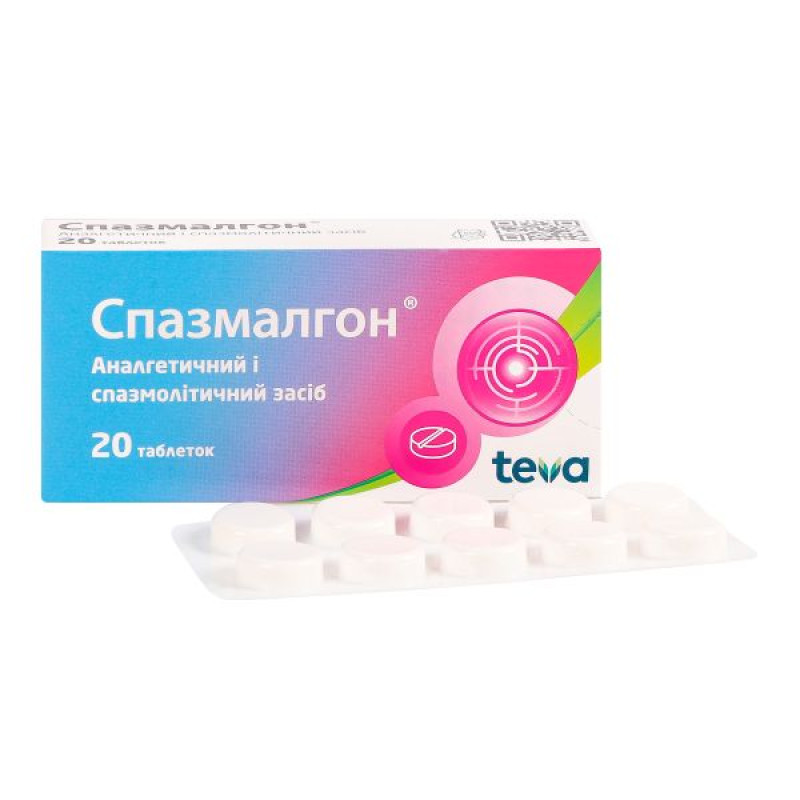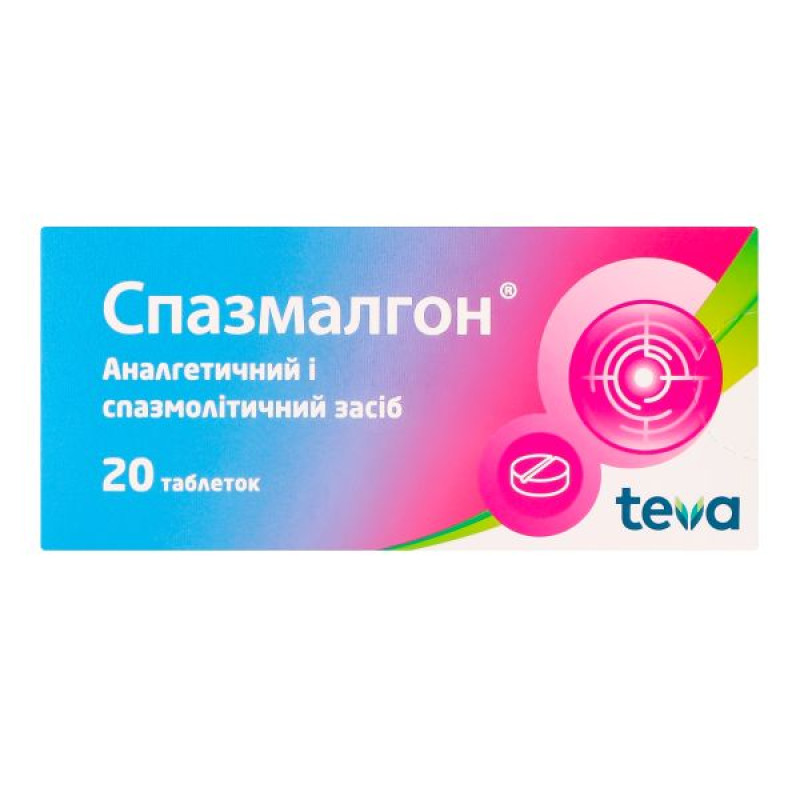Spazmalgon tablets blister No. 20

Instructions Spazmalgon tablets blister No. 20
Composition
active ingredients: metamizole sodium, pitophenone hydrochloride, fenpiverinium bromide;
1 tablet contains metamizole sodium 500 mg, pitofenone hydrochloride 5 mg, fenpiverinium bromide 0.1 mg;
excipients: lactose monohydrate, wheat starch, talc, magnesium stearate, gelatin, sodium bicarbonate.
Dosage form
Pills.
Main physicochemical properties: round, flat tablets with beveled edges, with a score line on one side, diameter 13 mm; color white or almost white.
Pharmacotherapeutic group
Antispasmodics in combination with analgesics. Synthetic anticholinergics in combination with analgesics. Pitofenone and analgesics. ATX code A03D A02.
Pharmacological properties
Pharmacodynamics
Spazmalgon® exhibits analgesic, spasmolytic (papaverine-like), anticholinergic (atropine-like) and some anti-inflammatory activity.
Metamizole has a pronounced analgesic and antipyretic effect in combination with less pronounced anti-inflammatory and antispasmodic activity. Its effects are the result of inhibition of the synthesis of prostaglandins and endogenous algogens, an increase in the threshold of excitability in the thalamus and the conduction of pain extero- and interoceptive impulses in the CNS, and it also affects the hypothalamus and the formation of endogenous pyrogens.
Fenpiverinium has a moderate ganglioblocking and parasympathetic effect, reduces the tone and motility of the smooth muscles of the stomach, intestines, biliary and urinary tracts.
Pitofenone has a papaverine-like effect on vascular and extravascular smooth muscle with a pronounced antispasmodic character.
Pharmacokinetics
Metamizole is characterized by rapid and complete resorption. After 30 minutes after internal administration, amounts of 50% of the maximum serum concentration are detected in the serum. It is partially bound to plasma proteins. It undergoes intensive biotransformation in the body. At the same time, its main metabolites are pharmacologically active. It is eliminated with urine in the form of metabolites. Only 3% of the amount excreted is unchanged metamizole. The degree of biotransformation is also influenced by the genetically determined type of acetylation. There is very little data in the available medical literature on the processes of resorption and distribution of pitofenone and fenpiverinium. It is known that resorption occurs in the upper parts of the gastrointestinal tract and is incomplete. Chemical compounds undergo significant ionization and have poor liposolubility, which determines the poor level of penetration through the blood-brain barrier. Their plasma concentration profile is biphasic.
Pitofenone and fenpiverinium are metabolized in the liver, mainly by oxidation, with about 90% of the substance excreted in the urine as metabolites and about 10% in the feces as unchanged compound. There is evidence that their half-life from blood plasma is 10 hours. Individual components are excreted in breast milk.
Indication
Symptomatic treatment of mild to moderate pain syndrome in spasms of smooth muscles of internal organs:
renal colic and inflammatory diseases of the urinary tract accompanied by pain and dysuric disorders;
stomach and intestinal spasms, hepatic colic, biliary dyskinesia;
spastic dysmenorrhea.
Contraindication
Hypersensitivity to metamizole, to pyrazolone or pyrazolidine derivatives or to any other component of the drug.
Gastrointestinal obstruction and megacolon.
Atony of the gallbladder or bladder.
Severe renal and hepatic dysfunction.
Blood diseases (agranulocytosis, leukopenia, anemia of any etiology, cytostatic or infectious neutropenia).
Glucose-6-phosphate dehydrogenase deficiency.
Porphyria.
Angle-closure glaucoma.
Suspicion of acute surgical pathology.
Bronchial asthma.
Collaptoid states.
Tachyarrhythmia.
Prostatic hypertrophy with a tendency to urinary retention.
Pregnancy and breastfeeding.
Interaction with other medicinal products and other types of interactions
Metamizole increases plasma concentrations of chloroquine, reduces plasma concentrations and effects of coumarin anticoagulants and cyclosporine.
Increases the hematotoxic effect of myelotoxic drugs, chloramphenicol.
Neuroleptics, sedatives and tranquilizers enhance the analgesic effect of metamizole.
Tempidone and tricyclic antidepressants, oral contraceptives, allopurinol slow down the metabolism of metamizole and increase its toxicity.
Barbiturates, phenylbutazone and other inducers of liver microsomal enzymes may reduce the effect of metamizole.
The combination of Spazmalgon® and other drugs requires special caution, given the content of metamizole, which is an enzyme inducer. Metamizole can induce drug-metabolizing enzymes, including CYP2B6 and CYP3A4. Concomitant use of metamizole with bupropion, efavirenz, methadone, valproate, cyclosporine, tacrolimus or sertraline may cause a decrease in the concentration of these drugs in the blood plasma with a potential decrease in clinical efficacy. Therefore, caution is recommended when using metamizole simultaneously, and if necessary, the clinical response and/or drug levels should be monitored.
Application features
The drug is used with caution:
– in case of impaired kidney and/or liver function;
– for stomach diseases (achalasia, gastroesophageal reflux, pyloric stenosis);
– with a tendency to arterial hypotension and orthostatic reactions;
– for chronic bronchitis and bronchospasm (Spazmalgon® increases the viscosity of bronchial secretions);
– in the presence of hyperthyroidism; prostatic hypertrophy;
– with severe cardiac rhythm disturbances, ischemic heart disease (especially with acute myocardial infarction), chronic congestive heart failure;
– if there is evidence of hypersensitivity to nonsteroidal anti-inflammatory drugs and/or non-narcotic analgesics or other manifestations of allergy (allergic rhinitis).
With prolonged use of Spazmalgon®, it is necessary to check the condition of peripheral blood and liver function.
The appearance or worsening of existing headaches is possible after prolonged analgesic treatment (>3 months) when using analgesics every other day or more frequently.
Headache caused by excessive use of analgesics should not be treated by increasing the dose. In such cases, analgesic treatment should be discontinued after consultation with a doctor.
The drug may affect the psychophysical state of patients when used simultaneously with alcohol and drugs that depress the CNS.
It is not recommended to use other medicines containing metamizole simultaneously with Spazmalgon®.
Drug-induced liver injury. Cases of acute hepatitis, predominantly hepatocellular in nature, have been reported in patients receiving metamizole, occurring within a few days to several months after initiation of treatment. Signs and symptoms included elevated serum liver enzymes, with or without jaundice, often in the context of other drug hypersensitivity reactions (e.g., skin rash, blood dyscrasias, fever, and eosinophilia) or with evidence of autoimmune hepatitis. Most patients recovered after discontinuation of metamizole, but in isolated cases progression to acute liver failure requiring liver transplantation has been reported. The mechanism of liver injury by metamizole is not clearly understood, but evidence suggests an immunoallergic nature. Patients should contact their physician if symptoms of liver injury occur. Metamizole should be discontinued in such patients and liver function should be evaluated. If there is a history of an episode of liver damage during treatment with metamizole, in which no other causes of liver damage have been identified, the drug should not be used again.
Severe skin reactions: Severe skin adverse reactions, including Stevens-Johnson syndrome, toxic epidermal necrolysis and drug reaction with eosinophilia and systemic symptoms (DRESS), which can be life-threatening or fatal, have been reported with metamizole treatment.
Patients should be informed of the signs and symptoms and monitored closely for skin reactions. If signs and symptoms suggestive of such reactions occur, metamizole should be discontinued immediately and the patient should not be given the drug again.
Wheat starch, gluten. This medicine contains very small amounts of gluten (considered gluten-free) and is unlikely to cause problems in patients with celiac disease. One tablet contains no more than 8.59 mcg of gluten. Patients with wheat allergy (other than celiac disease) should not take this medicine.
Lactose: This medicinal product contains lactose. Patients with rare hereditary problems of galactose intolerance, the Lapp lactase deficiency or glucose-galactose malabsorption should not take this medicinal product.
Metabolites of metamizole sodium can change the color of urine to red, which is of no clinical significance.
Use during pregnancy or breastfeeding
Do not use during pregnancy or breastfeeding.
Ability to influence reaction speed when driving vehicles or other mechanisms
When using the drug Spazmalgon®, caution should be exercised when driving or working with other mechanisms, as due to the presence of an anticholinergic effect, prolonged use of Spazmalgon® can lead to dizziness and impaired accommodation.
Method of administration and doses
Spazmalgon® tablets are taken orally after meals, with water. The recommended daily dose for adults and children over 15 years of age is 1–2 tablets per day; the maximum daily dose is 2 tablets.
The duration of use of Spazmalgon® is no more than 3 days.
The dose should be reduced in elderly patients, debilitated patients and patients with reduced creatinine clearance, as the elimination of metamizole metabolites may be prolonged.
Hepatic and renal insufficiency. Since the elimination rate of metamizole is reduced in patients with renal or hepatic insufficiency, repeated high doses of metamizole should be avoided. With short-term administration, dose reduction is not required. To date, there is insufficient experience with the long-term use of metamizole in patients with severe hepatic and renal insufficiency.
Children
Spasmalgon® is not prescribed to children under 15 years of age.
Overdose
Symptoms. In case of overdose, symptoms of metamizole intoxication in combination with anticholinergic effects predominate; impaired liver and kidney function, respiratory paralysis. Most often, toxic-allergic syndrome, symptoms of impaired hematopoietic functions, gastrointestinal disorders, and in severe cases, symptoms of brain damage are observed.
Treatment. If an overdose is suspected, the drug should be immediately discontinued and measures should be taken to rapidly eliminate it from the body (induce vomiting, perform gastric lavage, increase urine output). Symptomatic measures are used. There is no specific antidote.
Adverse reactions
Side effects when using Spazmalgon® are most often temporary and disappear after discontinuation of treatment.
Severe cutaneous adverse reactions, including Stevens-Johnson syndrome, toxic epidermal necrolysis and drug reaction with eosinophilia and systemic symptoms (DRESS), have been reported with metamizole treatment (see section 4.4).
Immune system: urticaria, skin rash, itching, conjunctivitis; rarely - bronchospasm, angioedema, anaphylactic shock, toxic epidermal necrolysis and Stevens-Johnson syndrome, drug reaction with eosinophilia and systemic symptoms (DRESS).
Gastrointestinal: discomfort, dry mouth, intestinal obstruction, exacerbation of gastritis and gastric and duodenal ulcers.
Hepatobiliary system: drug-induced liver injury, including acute hepatitis, jaundice and increased serum liver enzymes (see section "Special warnings and precautions for use").
From the cardiovascular system: palpitations, decreased blood pressure, tachycardia, heart rhythm disturbances.
From the nervous system: dizziness, visual disturbances.
From the hematopoietic system: granulocytopenia, anemia, agranulocytosis, thrombocytopenia, leukopenia.
From the urinary system: oliguria, anuria, urinary retention, proteinuria, urine staining in red, development of acute renal failure and interstitial nephritis. With prolonged use of high doses, a decrease in renal function is possible (especially in patients with a history of kidney disease), in some cases - papillary necrosis.
Other: decreased sweating.
Expiration date
2 years.
Storage conditions
Store in a dry place, protected from light, at a temperature not exceeding 25 ºС.
Keep out of reach of children.
Packaging
Tablets No. 10×1, No. 10×2, No. 10×5, No. 20×1 in blisters, in a package.
Vacation category
Without a prescription.
Producer
Balkanfarma-Dupnytsia JSC.
Location of the manufacturer and address of its place of business
3 Samokovskoe Shose St., Dupnitsa, 2600, Bulgaria.
There are no reviews for this product.
There are no reviews for this product, be the first to leave your review.
No questions about this product, be the first and ask your question.



